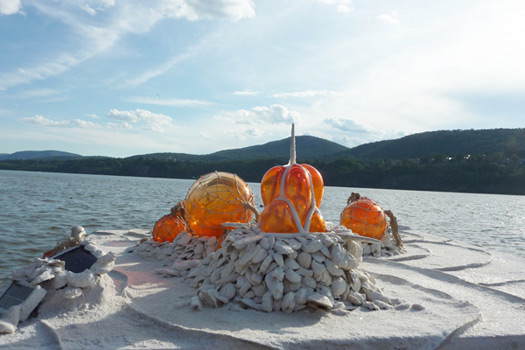
Above Image: Oyster Island The Ultimate Substrate for Future Aquatic Life in situ on the Hudson River @ Garrison’s Landing, Garrison NYC 201o
Oyster Island The Ultimate Substrate for Future Aquatic Life was part of a group show curated by the Garrisn Art Center in Garrison New York in the Summer of 2010.
Background text:
Once upon a time, vast oyster gardens populated New York’s harbor and estuaries. They filtered water, created natural beach breaks that protected the land, and provided habitat for over two hundred species of aquatic life. Their presence created a haven for bountiful thriving waterways.
Over the past four hundred years through overfishing, pollution, dredging, and disease New York’s oyster reef has been completely decimated.
Efforts are now underway to restore New York’s native oyster and create thriving reef once again. Governor’s island, the jewel of New York Harbor, is the center for these efforts. But oyster restoration cannot be done without the help of human intervention. This is because oyster reefs are self-perpetuating. Oysters love to settle on their own shell but there are no native shells left to settle on.
This means it is up to human efforts to fabricate reef structures for the future health of New York’s estuaries. The structures must be seeded with baby oysters, spat, to encourage growth. This sculpture was created with oyster colonization in mind. The materials used could be submerged and incorporated into living vital reefs or naturally disintegrate leaving no toxic residue behind. The goal is that in one hundred years all that will be left is healthy, vibrant reef and a restored estuary system with no sign of human intervention.
Oyster Island: Recipe for the Ultimate Urban Oyster Habitat
This recipe must be implemented in early spring when the water temperature gets warmer. Typically, oysters spawn in mass on the first full moon of the season. Find a spot with strong current from which oysters can receive the maximum amount of nutrients and oxygen possible. Keep the structure out of the general public’s way.
One oyster can filter up to 50 gallons of water per day. Since New York’s estuaries are polluted; oysters will be toxic for human consumption over the next 40 years.
The most crucial ingredient, calcium carbonate—the substance that shell is made of—is the basic building block for oyster reef. This recipe is designed for areas where reef no longer exists, so substitutions must be made for naturally occurring shell.
1) Use metal in seawater. Add low volts of electricity. Any kind of renewable energy source will do. If grown slowly the calcium carbonate is three times the strength of concrete and is naturally self-repairing.
2) Collect shell. Shell must be from waters north of New York City as southern shell is riddled with disease. Do not use restaurant shell.
3) Coat hard fire ceramic such as porcelain with calcium carbonate or pure lime. Other forms of calcium carbonate may be used such as aragonite, chalk, or even crushed marble.
4) Mix calcium carbonate into molten glass to create textured foam. This can be cast into any shape.
5) Create netted forms with natural fibers such as hemp rope, the least water-soluble fiber. Fill the nets with young oysters attached to substrate. Oysters will grow to fill the net with reef. The net will naturally disintegrate over time leaving no toxic residue and a healthy reef.
NOTE: this recipe does not use plastic or concrete.